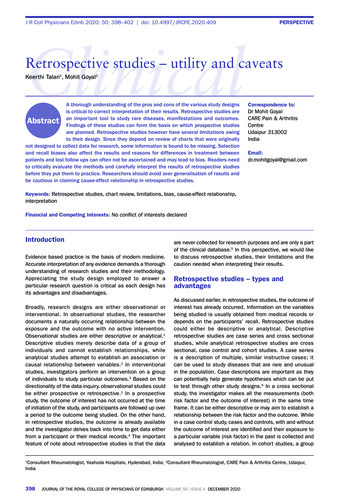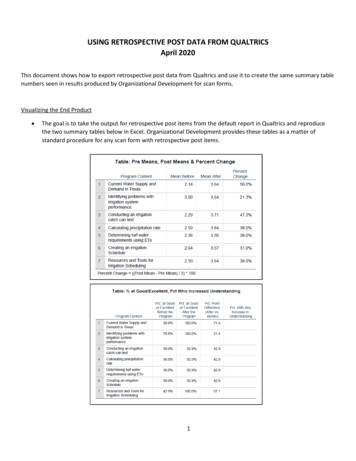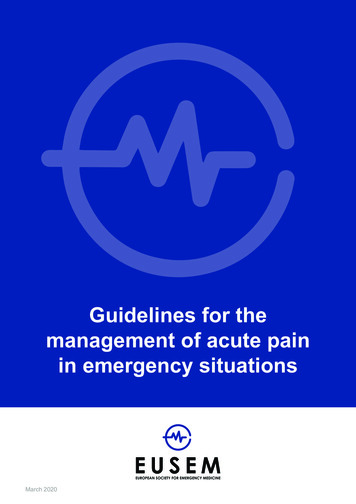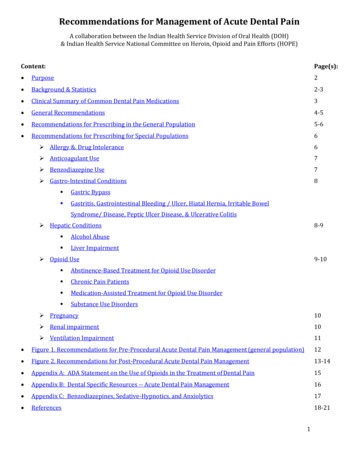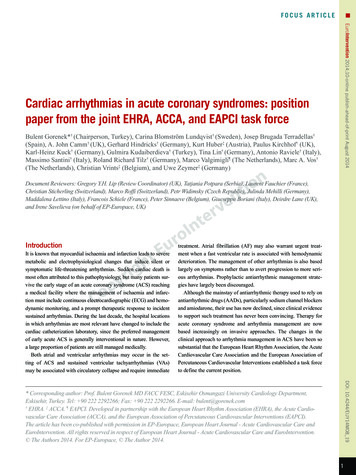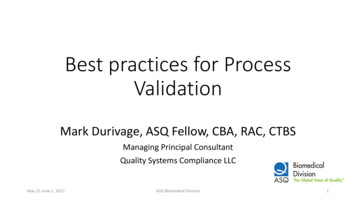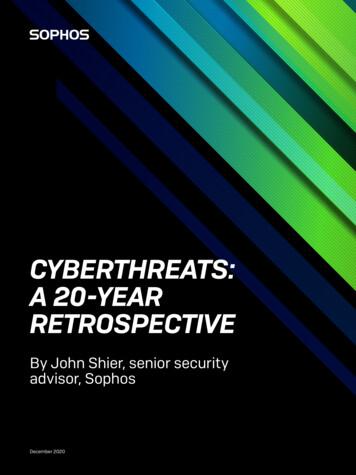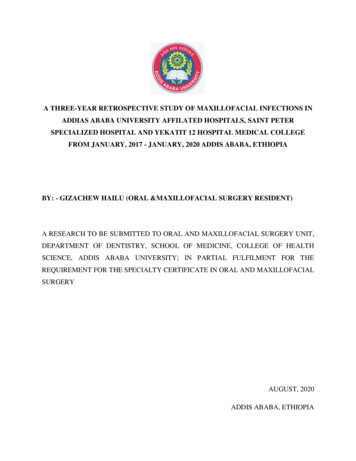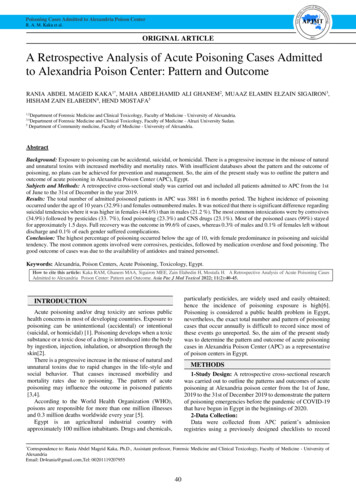
Transcription
Poisoning Cases Admitted to Alexandria Poison CenterR. A. M. Kaka et al.ORIGINAL ARTICLEA Retrospective Analysis of Acute Poisoning Cases Admittedto Alexandria Poison Center: Pattern and OutcomeRANIA ABDEL MAGEID KAKA1*, MAHA ABDELHAMID ALI GHANEM2, MUAAZ ELAMIN ELZAIN SIGAIRON3,HISHAM ZAIN ELABEDIN4, HEND MOSTAFA51,2Department of Forensic Medicine and Clinical Toxicology, Faculty of Medicine - University of Alexandria.Department of Forensic Medicine and Clinical Toxicology, Faculty of Medicine - Alrazi University Sudan.5Department of Community medicine, Faculty of Medicine - University of Alexandria.3,4AbstractBackground: Exposure to poisoning can be accidental, suicidal, or homicidal. There is a progressive increase in the misuse of naturaland unnatural toxins with increased morbidity and mortality rates. With insufficient databases about the pattern and the outcome ofpoisoning, no plans can be achieved for prevention and management. So, the aim of the present study was to outline the pattern andoutcome of acute poisoning in Alexandria Poison Center (APC), Egypt.Subjects and Methods: A retrospective cross-sectional study was carried out and included all patients admitted to APC from the 1stof June to the 31st of December in the year 2019.Results: The total number of admitted poisoned patients in APC was 3881 in 6 months period. The highest incidence of poisoningoccurred under the age of 10 years (32.9%) and females outnumbered males. It was noticed that there is significant difference regardingsuicidal tendencies where it was higher in females (44.6%) than in males (21.2 %). The most common intoxications were by corrosives(34.9%) followed by pesticides (33. 7%), food poisoning (23.3%) and CNS drugs (23.1%). Most of the poisoned cases (99%) stayedfor approximately 1.5 days. Full recovery was the outcome in 99.6% of cases, whereas 0.3% of males and 0.1% of females left withoutdischarge and 0.1% of each gender suffered complications.Conclusion: The highest percentage of poisoning occurred below the age of 10, with female predominance in poisoning and suicidaltendency. The most common agents involved were corrosives, pesticides, followed by medication overdose and food poisoning. Thegood outcome of cases was due to the availability of antidotes and trained personnel.Keywords: Alexandria, Poison Centers, Acute Poisoning, Toxicology, Egypt.How to cite this article: Kaka RAM, Ghanem MAA, Sigairon MEE, Zain Elabedin H, Mostafa H. A Retrospective Analysis of Acute Poisoning CasesAdmitted to Alexandria Poison Center: Pattern and Outcome. Asia Pac J Med Toxicol 2022; 11(2):40-45.particularly pesticides, are widely used and easily obtained;hence the incidence of poisoning exposure is high[6].Poisoning is considered a public health problem in Egypt,nevertheless, the exact total number and pattern of poisoningcases that occur annually is difficult to record since most ofthese events go unreported. So, the aim of the present studywas to determine the pattern and outcome of acute poisoningcases in Alexandria Poison Center (APC) as a representativeof poison centers in Egypt.INTRODUCTIONAcute poisoning and/or drug toxicity are serious publichealth concerns in most of developing countries. Exposure topoisoning can be unintentional (accidental) or intentional(suicidal, or homicidal) [1]. Poisoning develops when a toxicsubstance or a toxic dose of a drug is introduced into the bodyby ingestion, injection, inhalation, or absorption through theskin[2].There is a progressive increase in the misuse of natural andunnatural toxins due to rapid changes in the life-style andsocial behavior. That causes increased morbidity andmortality rates due to poisoning. The pattern of acutepoisoning may influence the outcome in poisoned patients[3,4].According to the World Health Organization (WHO),poisons are responsible for more than one million illnessesand 0.3 million deaths worldwide every year [5].Egypt is an agricultural industrial country withapproximately 100 million inhabitants. Drugs and chemicals,METHODS1-Study Design: A retrospective cross-sectional researchwas carried out to outline the patterns and outcomes of acutepoisoning at Alexandria poison center from the 1st of June,2019 to the 31st of December 2019 to demonstrate the patternof poisoning emergencies before the pandemic of COVID-19that have begun in Egypt in the beginnings of 2020.2-Data Collection:Data were collected from APC patient’s admissionregistries using a previously designed checklists to record*Correspondence to: Rania Abdel Mageid Kaka, Ph.D., Assistant professor, Forensic Medicine and Clinical Toxicology, Faculty of Medicine - University ofAlexandriaEmail: Dr4rania@gmail.com,Tel: 0020111920795540
ASIA PACIFIC JOURNAL of MEDICAL TOXICOLOGYAPJMT 11;2 http://apjmt.mums.ac.ir June 2022studied variables. Those variables included admitted patient’sdemographic characteristics, types of incriminated poisons,circumstances, route of poisoning, antidotes used, intensivecare unit admissions, duration of hospital stay as well as theoutcome.Pilot study was conducted before the fieldwork to assessthe feasibility of data collection using the previously designedtools, completion of patient admission registry, and the besttime of center visiting.Ethical considerations: Confidentiality of data wasensured throughout the study work after the ethics committee’sapproval. (IRB NO: 00007555 - -FWA NO: 00018699)complete only for 3381patiets. The age of the admittedpatients ranged from less than one year up to 86 years. Thehighest incidence of poisoning occurred in the age group of 1– 10 years (n 1113, 32.9% of cases) followed by 10 y-, 20y- both were 782 cases (23.1% each), then 30 y – 399 cases(11.8%), 40 y- 173cases (5.1), where the age group of 50years and more represents 2.8% of cases (93 patient). Theolder ages constituted small percentages of cases where theage group 60-70y represented 0.7% of total cases (22patients), 70-80 y occurred in 13 patients (0.4%) and only 4patients were over 80 years old.Females significantly outnumbered males in the studiedcases (60. 6%). The main route of administration of poisonswas via oral ingestion, followed by other routes as inhalationand skin contact with significant difference between bothgenders. (Table1). Circumstances of poisoning were mainlyaccidental in both sexes; but it was noticed that there was asignificant difference regarding suicidal tendencies where itwas higher in females (44.6%) than in males (21.2 %) (Table 1).Regarding the cause e of poisoning, the most commonpoisons involved were corrosives (34.9%) followed bypesticides (33.7%), food poisoning (23.3%) and centrallyacting drugs (23.1%). (Table 2). Required laboratoryinvestigations were carried out for all patients. Conservativetreatment was performed in all cases, and specific antidotes ormeasurements were needed in only 1234 patients (Table 3).Data AnalysisThe collected data were fed to the computer and analyzedusing IBM SPSS software package version 20.0. (Armonk,NY: IBM Corp). Mann Whitney test and Monte Carlo testswere used. The quantitative data were also described usingrange (minimum and maximum), mean, standard deviation,and median, while the qualitative data were described usingnumbers and percentages. The significance of the obtainedresults was judged at the 5% level.RESULTSDuring the study period, the total number of cases admittedto APC, was 3903 patients where the data registry wasTable 1. Distribution of the studied patients (n 3381) according to route and mode of administration of the poison and genderMalesN 1332Route of administrationFemalesN 2049p njection20.210.0Skin554.117MalesN 1332Mode of exposureX2 44.413pMC 0.001*0.8FemalesN 2049p 91444.6Homicidal10.100.0X2 193.764pMC 0.001*P*: significant at level 0.05*X2: Chi square test used to compare qualitative variablesPMC: Monte carlo significance of chi square testTable 2. Distribution of the studied patients according to type of poison and genderGenderType of poisonMalesFemalesTotal %N%N%1.Food poisoning1a.all types except Salted Fish19.21289.61979.61b. Salted Fish (feseekh)4.1201.5532.641
Poisoning Cases Admitted to Alexandria Poison CenterR. A. M. Kaka et al.Table 2. ContinuedGenderType of poisonMalesFemalesTotal %N%N%2. Alcohol7.4846.3231.13.Pesticides3a. 7271.33c.Aluminum .69624.7884.36.CNS drugs6a.Anticonvulsants4.2191.4582.86b.Sedative 522.57.Cough syrup1.6131.0130.68.Antibiotics0.520.270.39. CVS drugs9a.Antihypertensives4.9141.1773.89b.Cardiac medications3.4151.1482.310.Antidiabetic medications2.980.6472.311.Aminophylline , 13.Other drugs : antithyroid, hormones, cold preparations ,slimming tablets , Heroin0.2530.210.0514c.Hashish0.990.740.215.Snake ,scorpion sting4.3483.6150.716.Paints, cosmetics, toothpaste.etc1.3110.8110.517.Unknown substance ( usually children and parents didnot know or lie )12.81200.924311.918.Marine animal sting1100.840.219.Heavy metal (iron)0.850.480.45.Carbon monoxide COTable 3. Distribution of the studied patients according to type of received treatmentMalesN 1332Type of treatmentFemalesN 2049p valueN%N%72554.496447.020.2130.6Conservative and activated charcoal1047.832015.6Conservative and ative and gastric lavageConservative, gastric lavage and activated charcoalX2 59.100p 0.001*P*: significant at level 0.05*X2: Chi square test used to compare qualitative variablesdays (mean, 1.4 0.7 for males & 1.4 0.80 for females) withno significant difference between both genders (Table 4).Regarding the duration of hospital stay, most of thepoisoned cases stayed in the center for approximately 1.542
ASIA PACIFIC JOURNAL of MEDICAL TOXICOLOGYAPJMT 11;2 http://apjmt.mums.ac.ir June 2022(n 1113 32.9%), with accidental intentions in the majority.The females were (60.8%) of the total cases. Similar findingshave been reported from developed and developing countrieswho stated that poisoning of children less than 5 or 6 yearsold constituted the highest percentage of all poisoned casesunder accidental circumstances [7,8,9].Table 4. Distribution of the studied patients according to duration ofhospital stay and genderDuration of hospitalstay(days)MalesFemalesMean SD1.4 0.71.4 0.8Median1.01.0Min-Max1.0-12.01.0-21.0p value of MannWhitney testP 0.648Table 6. Distribution of the studied patients according to type ofpoison and ICU admissionp*: p value significant at level at 0.05Mann Whitney test: non parametric test used to compare quantitativevariables in two groupsICU admissionType of poisonN%1a. Salted Fish ( )فسيخ 11.72. Alcohol23.43a. Insecticides712.14.Corrosives23.45.Carbon monoxide CO11.76a.Anticonvulsants11.76b.Sedative hypnotics712.16c.Antipsychotics35.29b.Cardiac medications58.611.Aminophylline , theophylline11.7Other drugs : antithyroid, hormones, coldpreparations , slimming tablets , vitamins11.714a.Tramadol23.414b.Heroin11.715.Snake ,scorpion sting23.417.Unknown substance ( usually childrenand parents did not know or lie )2237.91.Food poisoningThe total number of ICU admissions was only 58 patients (29males and 29 female) with no significant difference betweenmales and females (Table 5). It was noticed that the highestpercentage of ICU admissions was among patients withunknown type and/or amount of the administrated poison(either the family did not notice, did not know, lied or tried totreat with home remedies) the cases arrived in a bad conditionand that necessitate ICU admission (Table 6).The outcome of studied patients was full recovery in99.6% of cases, whereas 0.3% of male cases and 0.1 cases offemales left without discharge and only 0.1% of each gendersuffered from complications (Table 5).DISCUSSIONMany people become ill or die yearly because of exposureto both manufactured chemicals and natural toxins. Mostpoisoning cases result from the lack of knowledge about risks,carelessness, misuse, or because of intended self-poisoning [4].APC is the largest national poison treatment center in the northcoast of Egypt, where thousands of poisoned patients arereceived yearly from different Egyptian governments. Thecurrent study included a total number of 3903 poisoned patientspresented to the APC during 6 months period in the year 2019.In 2011, Sahin [10] demonstrated comparable resultswhere 49.1% of all their patients were under four years.Yet, contrary to the current results of APC, they stated thatthe male/female ratio was 1:06, below 10 years.Age, Gender, and Circumstances of Poisoning:The current study revealed that in APC, the most commonage of poisoning occurred between the ages of 1 – 10 yearsTable 5. Distribution of the studied patients (n 3381) according to outcome , ICU admission, and genderMalesN 1332OutcomeFull recoveryFemalesN 2049p valueN%N%132799.6204599.8Permanent 92.2291.4X2 4.710pMC 0.177ICUP*: significant at level 0.05*X2: Chi square test used to compare qualitative variablesPMC: Monte carlo significance of chi square test43X2 2.779p 0.096
Poisoning Cases Admitted to Alexandria Poison CenterR. A. M. Kaka et al.However, female predominance was present in ages above10 years.The prevalence of poisoning at that young age may beexplained by the nature of children; they are active and tryingto explore the surroundings all the time by tasting or drinkingany drugs or chemicals around. They also may imitate adultsin some actions as taking the medications, but they have notany ability to understand the outcome of these actions.Mothers may not to describe medications as candies or buycandies that look like medications [7].On the other hand, a previous Egyptian study in AinShams in 2019 noticed that the majority of cases (59.3%)were from 15 to 40 years old followed by the age group lessthan seven years (26.4%). They attributed the high incidenceof poisoning at that age group to the great emotional, social,economic and political challenges in Egypt that may increasesuicidal attempts [11].Females’ predominance seen in APC was in agreementwith what was observed by Hewala [12] and with thosefindings in Ain Shams annual report in 2012 [13]. The samewas found in a Turkish study by Kesapli in 2018 [14] whichstated that females outnumbered males among poisonedcases. Female majority in our study could be due to high rateof family conflicts, domestic violence and emotional liabilityamong young women that may lead to psychological stress.Young women have high tendency to prefer suicidalattempts using different poisons or drugs as a way of escapefrom reality [15].Regarding the circumstances of poisoning, the highsuicidal intentions among females that was noticed in thepresent study was in accordance with what was revealed byHewala’s study in 2018 [12] where 44.6% of suicidal caseswere among females. Similar observation was reported inAin shams report in 2013 [13]. This was in contrast to whatwas stated in the Maryland poison center annual report 2019[16], which stated that most of the poisoned cases wereunintentional (68%).The Outcome:Hospital stays in APC ranged from 1-21 days with a meanof 1.46 0.80 days. We found that the hospital stays in APCwere longer than those in non-specialized hospitals inAlexandria and 1234 of the patients were provided withspecific antidotes. The outcome in APC was full recovery in99.6% of cases, whereas 0.35% of cases left withoutdischarge and 0.1% suffered complications.More extended hospital stays were observed with Galvaoand his colleagues in 2011 [21] during their study as rangedfrom 1-126 days. It is assumed that poison centers, with theirtrained team, should decrease the hospital stay and the costfor each patient, but this seemed to differ from country tocountry.On the contrary, King’s study in 2019 [22] stated thatthe presence of an in-patient medical toxicology servicewas associated with decreased patient stays in hospital andincreased reimbursement for admitted patients. Differencesmay be attributable to improved patient care provided bymedical toxicologists. Tak in 2017 compared the cost ofservices provided by poison centers and demonstratedeconomic value by reducing emergency department visitsand associated charges [23]. The ICU admission in thepresent study was 1.49 % of both sexes. That result wasbetter than Sulaj [24] who stated that 19.7% of the poisonedpatients were admitted to hospital during their study, ofwhich 10.2% were admitted to the ICU. Moreover, weobtained better results than Sharma [25], who carried out astudy in India, where the average stay in the hospital was12.53 7.53 days, and mortality rate was 42 (8.31%). Thiscan be explained by the availability of many poisons’antidotes for many poisons in APC.CONCLUSIONThis study established the magnitude of poisoning in avery special region of the north coast of Egypt. It revealedthat young and middle-aged people were the most susceptiblefor acute poisoning. In addition, children younger than tenyears accounted for about 33% of cases. Femalesoutnumbered males. The foremost route of poisoning wasingestion and suicidal poisoning predominated. Corrosivesand detergents were the most commonly involved toxicsubstances followed by organophosphates.Route of Administration and Types of Poisoning:In the current work, the most common route ofintoxication was the oral route. A similar result met with theMaryland report, where oral exposure accounted for 58.0%of cases while skin exposure and inhalation accounted for25.3% and 7.5% respectively [16]. This agreed also withAsawari’s study in 2017 [17] where oral ingestion was themain route of exposure, this could reflect the increasedpossibility of suicidal attempts or household accidentalexposure and decreased likelihood of environmental andoccupational exposures in our study.The most common causes of poisoning in the presentstudy were corrosives, pesticides, food poisoning andcentrally acting drugs. Similar results were mentioned byHewala [12], Ain shams report [13], and Kepsali [14]. Thewide availability together with the easy accessibility of manychemicals and drugs in the market in both developed anddeveloping countries have played a major role in suchpoisoning problem [16,18]. Several studies and reports foundthat pesticides were among those chemicals, and theyconstitute a problem in many countries [19,20].Recommendations:Egypt requires a new governmental laws/policy tocontrol household products and insecticides freeavailability as well as medication marketing. Collaborationbetween poison centers all over the country is essential toprovide an accurate data and mapping of poisoning in Egyptand to outline a national protocol for management ofdifferent cases of poisoning. Patients with suicidalpoisoning should undergo psychiatric consultation todecrease the risk of repeating those attempts. Healtheducation and awareness programs for the communityabout hazards of household chemical agents andinsecticides together with effective poison informationcenter are considered important strategies for the preventionof these emergencies.44
ASIA PACIFIC JOURNAL of MEDICAL TOXICOLOGYAPJMT 11;2 http://apjmt.mums.ac.ir June 202210. Sahin S, Carman KB, Dinleyici EC. Acute poisoning inchildren; data of a pediatric emergency unit. Iran J Pediatr.2011;21(4):479-484.11. Abdelhamid W. Evaluation of Severity of Poisoning Exposuresamong Patients Presented to Poison Control Center, Ain ShamsUniversity Hospitals, Egypt during 2019. Ain Shams J ForensicMed Clin Toxicol 1/2021 (36): 106-22.12. Salma Abdullah Mohammed Hewala. Assessment of resourcesand services utilization of Alexandria poison center. Thesis ofForensic Medicine and Clinical Toxicology. 2018 – Faculty //srv4.eulc.edu.eg/eulc v5/Libraries/Thesis/BrowseThesisPages.aspx?fn PublicDrawThesis&BibID 12515564.13. Mohy K. El Masry and Hany M. Tawfik, 2011 annual report ofthe poison control center of Ain shams university hospital,Cairo, Egypt. Ain shams journal of forensic medicine andclinical toxicology 2013; 20:10-17.14. Kesapli M, Celik A, Isik I. Characteristic Features of Childhoodand Adolescent Poisonings, in the Mediterranean Region over6 Years. Iran J Public Health. 2018 Nov;47(11):1667–74.15. Albert PR. Why is depression more prevalent in women? /jpn.150205.16. 2019 Annual Report from the Maryland Poison s/2019MPCAnnualReport Final.pdf .17. Asawari R, Atmaram P, Bhagwan K, Priti D, Kavya S, JabeenGA. Toxicological Pattern of Poisoning in Urban Hospitals ofWestern India. J Young Pharm. 2017; 9(3):315-20.18. Pelkonen M1, Marttunen M. Child and adolescent suicide:epidemiology, risk factors, and approaches to prevention.Paediatric Drugs. 2003;5(4):243-65.19. Paudyal BP. Organophosphorus poisoning. JNMA J NepalMed Assoc 2008; 47:251–8.20. Presgrave RF, Camacho LA, Villas Boas MH. A profile ofunintentional poisoning caused by household cleaningproducts, disinfectants and pesticides. Cad Saude Publica 2008;24:2901–8.21. Galvao TF, Silva MT, Silva CD, Barotto AM, Gavioli IL,Bucaretchi F, et al. Impact of a poison control center on thelength of hospital stay of poisoned patients: retrospectivecohort. Sao Paulo Med J. 2011 Jan;129(1):23–9.22. King AM, Danagoulian S, Lynch M, Menke N, Mu Y, SaulM, et al. The Effect of a Medical Toxicology Inpatient Servicein an Academic Tertiary Care Referral Center. J Med Toxicol.2019 Jan;15(1):12-21. doi: 10.1007/s13181-018-0684-2.23. Tak CR, Malheiro MC, Bennett HK, Crouch BI. The value of apoison control center in preventing unnecessary ED visits andhospital charges: A multi-year analysis. Am J Emerg Med. 2017Mar;35(3):438-43. doi: 10.1016/j.ajem.2016.11.049.24. Sulaj Z, Prifti E, Demiraj A, Strakosha A. Early ClinicalOutcome of Acute Poisoning Cases Treated in Intensive darh.2015.69.400-404.25. Sharma R, Neelanjana, Rawat N, Panwar N. Mortality andmorbidity associated with acute poisoning cases in north-eastIndia: A retrospective study. J Family Med Prim Care.2019;8(6):2068-72. doi:10.4103/jfmpc.jfmpc 237 19.LIMITATIONSAlthough the retrospective design of the study limited thedata that could be collected and thorough follow-up ofpatients, we believe that the number of possible missed caseswas low. Several physicians made the data collection, and theinter-rater variability is not known. Scanning of forms maylead to errors, which were avoided by manually entering theoriginal forms. Poisoning severity score (PSS) is a simple toolfor assessment and referral of cases, yet it was not used in thestudy as it was deficient in registries.ACKNOWLEDGMENTSThe authors would like to acknowledge the staff membersat Alexandria poison center for their cooperation and patiencein providing registries needed for collecting retrospectivedata.Funding and Support: None.Conflict of Interest: None to be declared.REFERENCES1.2.3.4.5.6.7.8.9.Tawfik H, El Helaly H. Toxicological Profile of AcutelyPoisoned Cases Admitted to Poison Control Center, Ain-ShamsUniversity Hospitals during Year 2013. Ain Shams Journal ofForensic Medicine and Clinical Toxicology, 2015; 24(1): 154163.Mowry JB, Spyker DA, Brooks DE, McMillan N, Schauben JL.2014 Annual Report of the American Association of PoisonControl Centers' National Poison Data System (NPDS): 32ndAnnual Report. Clin Toxicol. 2014; 53: 962-1147.Thundiyil JG, Stober J, Besbelli N, Pronczuk J. Acute pesticidepoisoning: a proposed classification tool. Bull World HealthOrgan. 2008; 86: 205-9.Michael W, Stefen W, Michael J. Haddad and Winchester, sclinical management of poisoning and drug overdose. 4th ed.2007; 5-10.International Programme on Chemical Safety. Poison centersWorld health organization 2018, reviewed poisons/prevention guidelines/en/The use of pesticides in developing countries and their impacton health and the right to food. Policy Department for ExternalRelations. Directorate General for External Policies of theUnion PE 653.622 – January2021. Available /STUD/2021/653622/EXPO STU(2021)653622 EN.pdf.Sobeeh F, El-Hay N, Draz E, Saad K. Pattern of acute pediatricpoisoning in Middle Delta Poison Control Centers. Tanta MedJ. 2018 Jan 1; 46: 215.Alvin C, Daniel A, Louis R. 2010 Annual Report of theAmerican Association of Poison control centers, Nationalpoison data system (NPDS):28th Annual Report. ClinicalToxicology 2011;49: 910-40.Halhalli HC, Uslu T. Evaluation of Pediatric Patients Admittedto the Emergency Department Due to Drug Intoxication.Cureus. 2021;13(2):e13366. Published 2021 Feb 16.doi:10.7759/cureus.13366.45
outcome of acute poisoning in Alexandria Poison Center (APC), Egypt. Subjects and Methods: A retrospective cross-sectional study was carried out and included all patients admitted to APC from the 1st of June to the 31st of December in the year 2019. Results: The total number of admitted poisoned patients in APC was 3881 in 6 months period. The .
